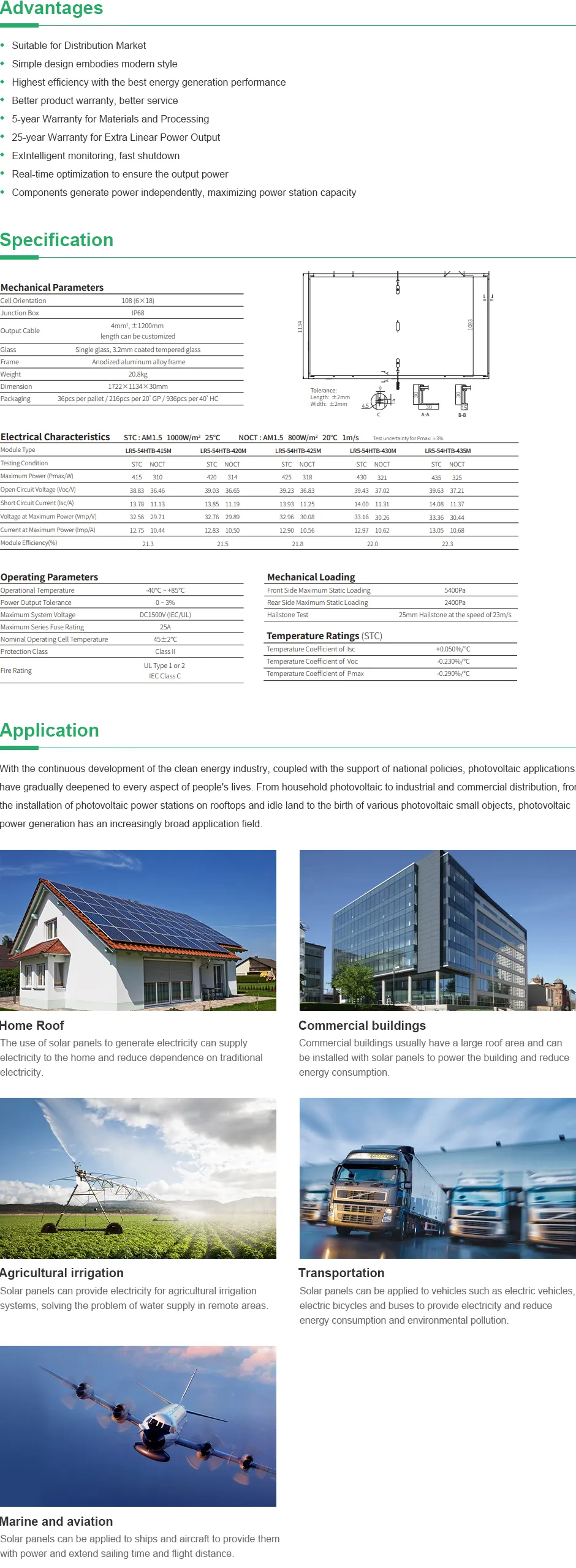Optimal Solar Panel Dimensions for Residential Use and Their Impact on Energy Production
Understanding Solar Panel Sizes for Home Use
As the push for renewable energy continues to gain momentum, solar panels have emerged as a popular choice for homeowners looking to reduce their carbon footprint and save on energy costs. However, one critical factor to consider when installing solar panels is their size. Understanding the size of solar panels suitable for home use can help homeowners make informed decisions about their solar energy systems.
What Are Solar Panels?
Solar panels are devices that convert sunlight into electricity. They are made up of photovoltaic (PV) cells, which capture sunlight and convert it into direct current (DC) electricity. This electricity can then be converted into alternating current (AC) for use in home appliances. Solar panels come in various sizes and wattages, allowing consumers to choose the best option for their specific energy needs.
Standard Sizes of Solar Panels
Most residential solar panels fall into the range of 60 to 72 cells, which typically translates to sizes of about 65 to 70 inches in height and 39 to 40 inches in width. The most common sizes include
1. Standard Residential Panels These panels are usually rated between 250 to 400 watts. A standard 300-watt panel often measures around 65 inches tall and 39 inches wide. 2. Compact or Smaller Panels Some homeowners may opt for smaller panels, especially if they have limited roof space or irregular roof shapes. These panels may have a lower wattage, such as 100 to 250 watts.
3. Large Format Panels For homeowners with ample roof space, larger panels (often 72 cells) are available, commonly rated around 350 to 450 watts. These panels are ideal for maximizing energy production.
Factors Affecting Solar Panel Size Choice
solar panels size for home

When deciding on the appropriate solar panel size for a home, several factors must be considered
1. Energy Needs Begin by evaluating the household's energy consumption. Understanding how much electricity is used monthly will help determine the total power generation needed from solar panels. Tools like watt-meters or utility bills can assist in this assessment.
2. Available Roof Space Roof size and orientation can significantly affect the number of panels that can be installed. Homes with smaller or shaded roofs may require smaller panels or a reduced number of panels to optimize energy production.
3. Local Climate The amount of sunlight your home receives plays a critical role in solar energy production. In sunnier regions, fewer panels might be needed to achieve the same energy goals compared to areas with more cloudy days.
4. Budget Constraints Solar panel prices can vary, so consider the budget available for the entire solar system, including installation costs. Larger panels tend to produce more power and might offer better efficiency, but they may come at a higher upfront cost.
5. Inverter Specifications The type of inverter required for the system also influences panel size. Ensure that the inverter can handle the wattage produced by the solar panels chosen.
Conclusion
Choosing the right solar panel size for your home is crucial for maximizing efficiency and ensuring that your system meets your energy requirements. With numerous panel sizes and wattage options available, conducting thorough research and consulting with a solar energy professional can help homeowners determine the best solution for their specific needs. By harnessing the power of the sun, homeowners not only contribute to environmental sustainability but also enjoy significant savings on their energy bills in the long run.
-
String Solar Inverter: The High-Efficiency Solution for Smart Solar EnergyNewsJul.14,2025
-
Revolutionizing Rooftop Energy with the Power of the Micro Solar InverterNewsJul.14,2025
-
Power Independence with Smart Off Grid Solar Inverter SolutionsNewsJul.14,2025
-
On Grid Solar Inverter: Powering the Future with Smart Grid IntegrationNewsJul.14,2025
-
Monocrystalline Solar Panels: High-Efficiency Power for the Future of Clean EnergyNewsJul.14,2025
-
Bifacial Solar Panel: A Smarter Investment for Next-Generation Energy SystemsNewsJul.14,2025







